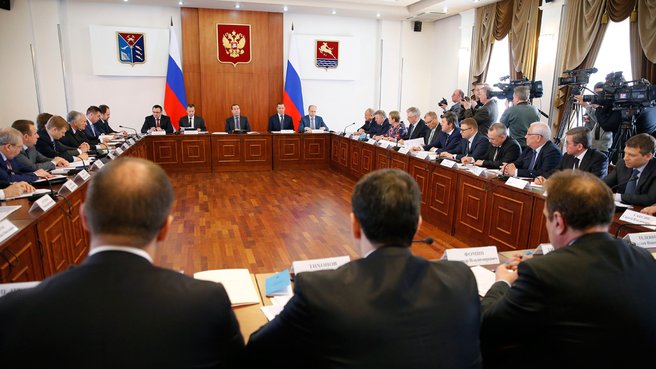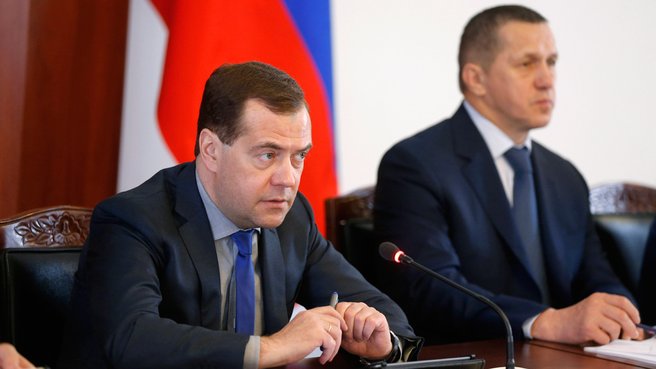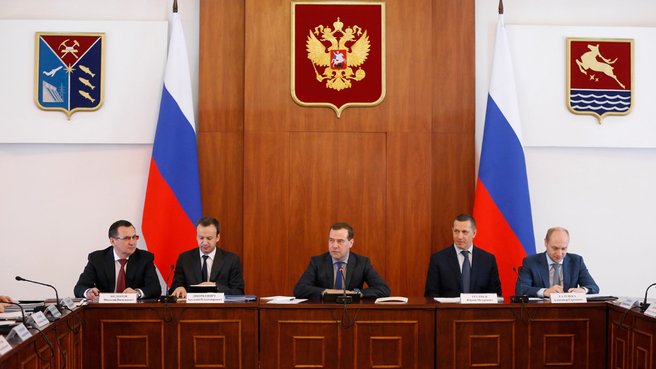Dmitry Medvedev’s visit to Magadan.
Dmitry Medvedev’s opening remarks:
The current meeting is devoted to the development of the fishing industry, not only in Magadan but in the country as a whole, with some emphasis on our northern territories. <… >
The fishing industry has demonstrated certain growth in the past five years. The catch of fish has increased by 13%. If we compare the absolute figures for 2009 and 2013, the production of fish and fish products grew by 12%.
Dmitry Medvedev: "The catch of fish has increased by 13%. If we compare the absolute figures for 2009 and 2013, the production of fish and fish products grew by 12%."
The share of domestic fish products on the national market increased from 72.5% in 2009 to over 78% in 2013. However, the threshold that we’ve established for our country with due account of the global experience should reach 80% in line with the Food Security Doctrine. We are not far off from this figure, but we’d like to surpass it, all the more since we have unique opportunities in this sphere compared with many other states.
One more important indicator is that fish is increasingly often appearing on our tables. In tentative estimates, last year every Russian ate 22 kg of fish, or over two kg more than in 2009. <…> The export potential of our fisheries is generally high. According to Rosstat (the Federal Statistics Service), Russia increased its exports of fish and fish products by 37% over this period. Fish imports grew by 6% over these five years. For the most part, we’re exporting our produce to the countries of the Asia-Pacific Region, which are close to the fishing areas – it is easier and more profitable to cooperate with them. At the same time almost all imports go to Russia’s European part, which is populated by the majority of our people. So, we also have a disparity in this respect.
Dmitry Medvedev: "In tentative estimates, last year every Russian ate 22 kg of fish, or over two kg more than in 2009."
We’ve done much in the last few years to put things in order in our fishing industry. We have formulated the relevant norms and adopted a state programme on developing the fisheries industry from 2013 to 2020. It sets our guidelines. We plan to allocate 83 billion roubles from the federal budget for its implementation.
The state has started fixing fishing quotas for entrepreneurs for 10 years. So now they can plan for a longer term and be motivated to invest more and expand the scale of their business.
The decision on mandatory delivery of all fish caught in Russia’s exclusive economic zone to our territory has made the industry more transparent. Experts developed an industry-specific system of monitoring that is being used not only by the Federal Agency for Fishery but also by the Federal Security Service. All these efforts have reducing illegal fishing. The practice is still widespread but there is a clear trend towards its reduction. At any rate, experts have calculated that poaching has decreased by more than 66% over the past decade. Needless to say, this is again an average figure – it is better in some places and worse in others.
Aquaculture or commodity fish farming can also contribute to the development of the fishing industry. This is confirmed by global experience: in 2006-2011 the sale of global fishing stood at the level of 90 million tonnes a year, whereas aquaculture production grew from 47 to 63 million tonnes or by more than one third over the same period. So this is a clear trend.
Dmitry Medvedev: "In 2006-2011 the sale of global fishing stood at the level of 90 million tonnes a year, whereas aquaculture production grew from 47 to 63 million tonnes or by more than one third over the same period."
Aquaculture occupies a major place in the world structure of caught bioresources. Its share depends on the structure of consumption in different countries and the equipment of their fishing industries. I’m referring to countries with an outlet to the sea. Thus, in Israel aquaculture production accounts for 88% of the total catch. The relevant figure for China is 70%, for Norway 33% and for Japan 13%. It is easy to guess why the figure for Japan is so low. We are next door, so they don’t need to take part in this – it is easier to get it from Russia, legally or otherwise.
On the whole, the share of fish farming in the world’s catch amounts to 40%. We account for a mere three percent of global aquaculture production. We have a tremendous potential for developing it. Considering the length of our coasts and the area of our domestic fresh-water lakes we are capable of carrying out a real revolution in this regard.
<…>










